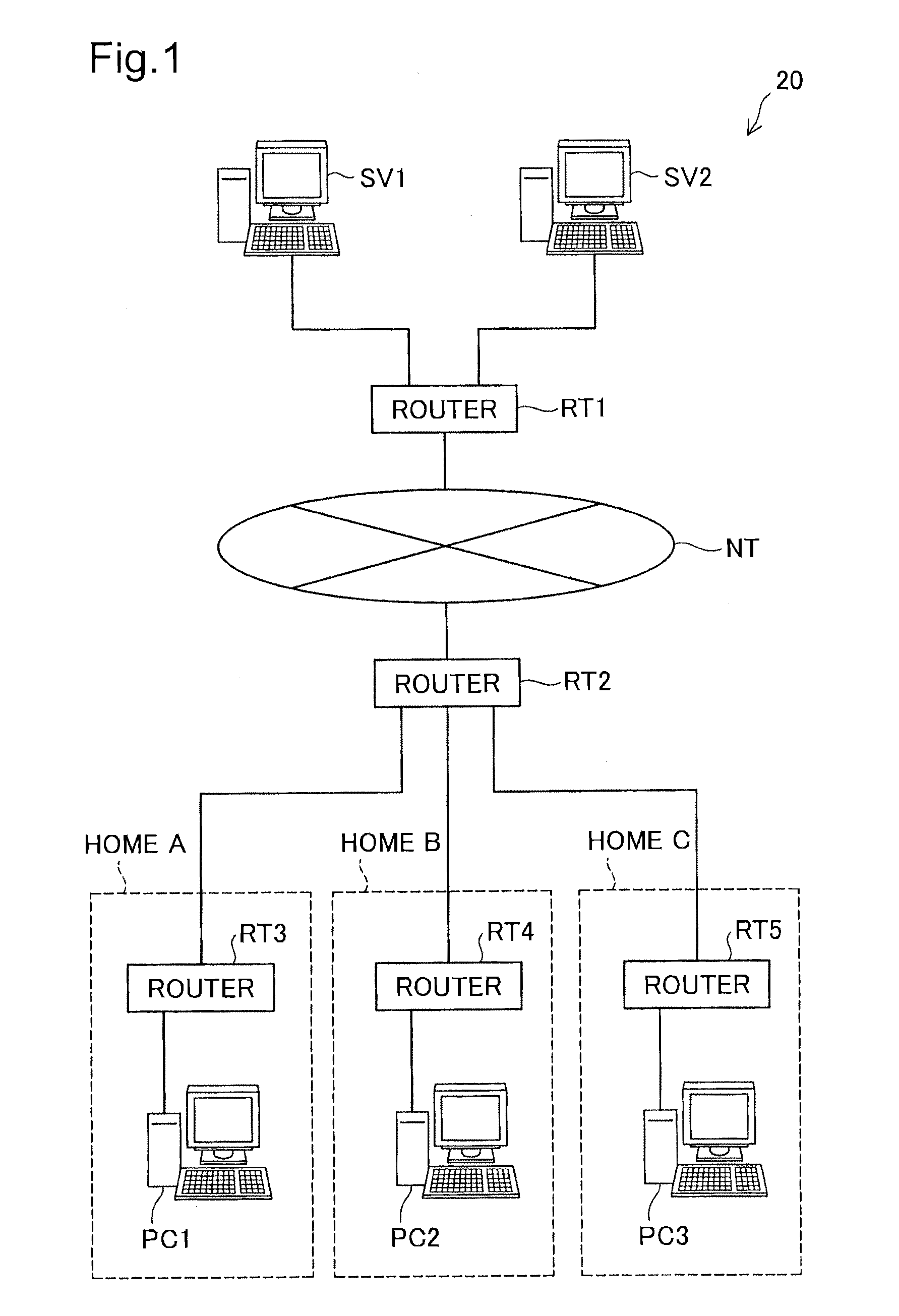Relay device and relay method
a relay device and communication packet technology, applied in the field of relay technique of communication packets, can solve the problems of difficult to provide the same number of several million queues corresponding to the number of several million users, unpractical, and remarkable cost increase, so as to save device cost, eliminate uneven distribution of communication packets, and achieve the effect of small cos
- Summary
- Abstract
- Description
- Claims
- Application Information
AI Technical Summary
Benefits of technology
Problems solved by technology
Method used
Image
Examples
first embodiment
A. First Embodiment
[0025]Embodiments of the invention are described, by way of example only, with reference to the accompanying drawings.
[0026]An exemplary network configuration including routers RT1 and RT2 according to one embodiment of the relay device of the invention is shown in FIG. 1 as a communication system 20. The communication system 20 is constructed as a network system providing the user with contents, such as videos, by streaming. As illustrated, the communication system 20 includes servers SV1 and SV2, routers RT1 to RT5 and personal computers PC1 to PC3.
[0027]The servers SV1 and SV2 store various contents and provide the user with the stored contents. These servers SV1 and SV2 are directly connected to the router RT1. For the convenience of description, the number of servers connected to the router RT1 is two according to the illustrated embodiment. But this number is not restrictive, and three or more servers may be connected to the router ...
second embodiment
B. Second Embodiment
[0049]According to a second embodiment of the invention, a router RT1 sorts communication packets, based on both the destination information and the port information, unlike the first embodiment. Otherwise the system configuration of the second embodiment is identical with that of the first embodiment. The general structure of the router RT1 according to the second embodiment is shown in FIG. 3. The like components shown in FIG. 3 to those of the first embodiment shown in FIG. 2 are expressed by the like symbols and are not specifically described here. Two components of the second embodiment corresponding to one component of the first embodiment are expressed by the like symbol with suffixes “a” and “b” for the purpose of distinction and are only briefly described. As shown in FIG. 3, the router RT1 according to the second embodiment includes an input module 110, sorters 120a and 120b, buffers 130a and 130b, band controllers 140a and 140b, an output module 150, d...
third embodiment
C. Third Embodiment
C-1. Device Structure
[0055]According to a third embodiment of the invention, a router RT1 transfers a communication packet, which is sorted to a queue detected as congestion, to an importance analyzer 190 and changes the discard priority corresponding to the degree of importance of the communication packet. This is the primary difference from the system of the first embodiment, as described in detail below.
[0056]The general structure of the router RT1 according to the third embodiment is shown in FIG. 4. With reference to FIG. 4, the router RT1 of the third embodiment includes an input module 110, a sorter 120, a buffer 130, a band controller 140, an output module 150, a discard detector 160, a process modifier 180 and an importance analyzer 190. The primary differences from the first embodiment are addition of the process modifier 180 and the importance analyzer 190, as well as series of operations of the sorter 120 and the buffer 130 as described below in detail...
PUM
 Login to View More
Login to View More Abstract
Description
Claims
Application Information
 Login to View More
Login to View More - R&D
- Intellectual Property
- Life Sciences
- Materials
- Tech Scout
- Unparalleled Data Quality
- Higher Quality Content
- 60% Fewer Hallucinations
Browse by: Latest US Patents, China's latest patents, Technical Efficacy Thesaurus, Application Domain, Technology Topic, Popular Technical Reports.
© 2025 PatSnap. All rights reserved.Legal|Privacy policy|Modern Slavery Act Transparency Statement|Sitemap|About US| Contact US: help@patsnap.com



